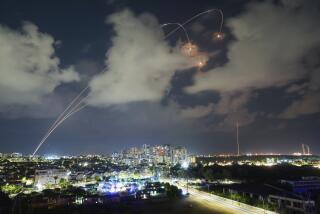Proud Wizards of Weaponry : Aerospace: The engineers who designed the expensive, high-tech systems so effective in the early days of the Gulf War feel pride and vindication.
- Share via
The images of the havoc brought by her handiwork were stark--and sobering. The surgical precision of the bombing raids over Baghdad in the opening hours of the Persian Gulf War. The missile-nose view of an Iraqi air defense headquarters imploding--Nintendo-style--in Friday’s predawn darkness.
And Leslie Abernathy, a young engineer at Hughes radar systems group in El Segundo, quickly realized that how she views her job has been forever changed.
“It’s easy for aerospace engineers to get lost in the ‘specs’ and the technical problems of their projects, and not to think about how these things are actually meant to be used,” said Abernathy, a 27-year-old electrical engineer assigned to the next generation of sophisticated radar still in Hughes’ development laboratories. “But when you see war, it definitely brings home the meaning of what we’re doing. It’s not a game or a problem to be solved. We build weapons for war.”
Perhaps as never before, this message is sinking into the collective consciousness of Southern California, home to the world’s largest concentration of aerospace engineers. Their attitude is not one of anguish or hand-wringing apologies but of straightforward realism: For aerospace engineers, the “proof of the pudding” comes not in qualifying competitions, contract bidding or even field testing, but in battle.
And now that their work is being submitted to the ultimate test and is apparently a rousing success in the opening days of the war, these engineers are expressing pride in their accomplishments and those of the bomber and fighter pilots deploying their products.
Among the proud are hundreds of Hughes radar engineers in El Segundo, whose systems are the guidance and detection brains of the F-14, F-15 and F-18 planes that have been bombing Iraq.
“We’ve always thought our radar was effective and reliable,” said Kent Schliching, a Hughes project engineer. “And the early days of the war just confirm our opinions. . . . When you see how good your designs are and that they do what they’re supposed to do, you do get a little bit of satisfaction.”
The engineers said the true value of the systems has been proven by the relatively low number of allied casualties during the initial bombing runs. They argue that the sophisticated high technology built into the latest weapons, although expensive and complicated, is worth the cost and effort because it can save the lives of its users.
“Good engineering doesn’t come cheap,” said William Bynum, former superintendent of Hughes’ F-14 radar product line. “And, hopefully, the man on the street is going to appreciate the value of these products and the ‘bang for the buck’ you get with them.”
Floyd Godsey, a Hughes radar project manager, said he expects the strong showing of the new high-tech weaponry to win over taxpayers who have misunderstood the purpose for deploying the more complex systems. He said the weapons and engineers will be vindicated as the public understands that the pinpoint accuracy of the systems can minimize civilian casualties and delay the onset of bloody battle between ground forces.
“You have to sell the connection between billion-dollar technology and minimal casualties,” Godsey said. “That’s the next challenge for engineers.”
More to Read
Sign up for Essential California
The most important California stories and recommendations in your inbox every morning.
You may occasionally receive promotional content from the Los Angeles Times.













